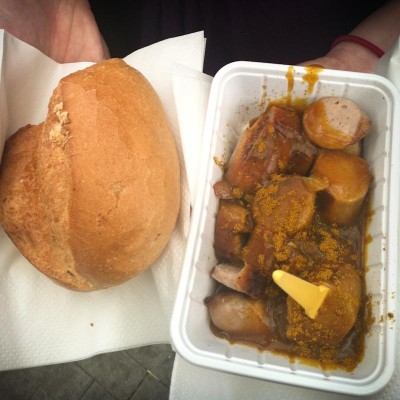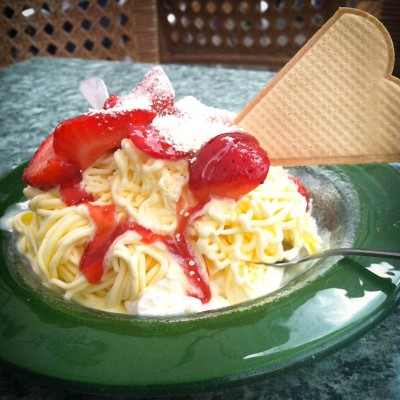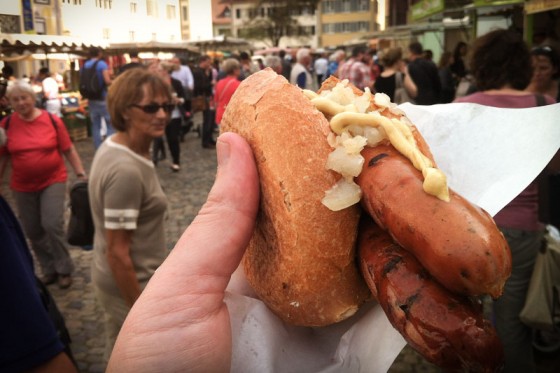A culinary tour of Germany reveals a delicious and diverse cuisine, with plenty of opportunities to partake right here in Seattle.
I have plenty of fond memories of German food from family vacations during my early teenage years: Eating bratwurst on the steps of the Frankfurt Cathedral. Endless visits to the ice cream stand in Kassel.
The food I ate during those trips was typical German fare: sausages or variations of schnitzel, usually accompanied by potatoes and, in my father’s case, a nice cold beer.
Since then, I moved to Seattle and became a bit of a foodie. So when I decided to travel to Germany again for the first time in seven years, I made it my goal to transcend the typical biergarten sausage platters and mountains of potatoes and reacquaint myself with real German cuisine.

My first stop was Berlin.
After exploring Alexanderplatz in the city’s center, my travel companion and I were in need of some dinner. We chose a restaurant in the main square and ordered Variationspätzle, a mix of minced vegetables, ham and spätzle.
Spätzle is an egg noodle-dumpling hybrid found throughout Germany (but a rarity at German places in the states). The dough is hand rolled and then cut into irregular strips and then boiled to create chewy noodles. Once it’s been pan-fried with butter, meat and veggies, the spätzle soak up the mix of juices and become moist and flavorful.
German chefs also have their own take on classic American macaroni and cheese with a dish called Käsespätzle. Instead of being made with cheddar or neon “cheese powder,” the noodles are mixed into a sauce of Emmentaler cheese and onion. Like its American counterpart, this dish will sit like a cheesy, delicious brick in your stomach for the rest of the evening. Who says that’s a bad thing?
The next night, during a pub-crawl through downtown Berlin, my friend and I were introduced to Döner Kebab.
This street food staple is the Turkish-German immigrants’ answer to Greek gyros, and can be found on nearly every corner.
The Döner is similar to its Mediterranean counterpart. While the Greek gyros are like a Mediterranean taco, the German Döner comes in pita or lavash, making it more of a sandwich or burrito. Döner pitas are stuffed with seasoned beef, chicken or falafel with a salad of cucumber, cabbage, lettuce, tomato and a number of sauce options.
For many Germans, Döner Kebab is the ultimate late night snack or, as a fellow bar-hopper described, “It’s like the German version of Taco Bell…but way better.”

Upon arriving in Cologne, in Western Germany, we found a Currywurst kiosk waiting outside the train station. Many Imbissbude, or fast-food stands, carry this beloved snack. It consists of a sliced, grilled bratwurst smothered in a brown curry sauce and is usually accompanied with brötchen, a small, crusty roll.
Currywurst is usually eaten on the run, so it’s served in a plastic to-go container with a tiny fork. Don’t worry, it is not impolite to mop up the excess sauce with the roll.
In Germany, summer means Pfifferling, or chanterelle season. When my friend and I sat down for a glass of Kölner Kölsch, the local brew, I ordered fresh mushrooms with Semmelknödel, which are handmade wheat dumplings. The dish is served in a cream sauce, which is one of the Germans’ favorite ways to eat just about anything. The mushrooms were meaty and the dumplings dense with the cream sauce. Like a lot of German food, this was certainly not a light dish. But hey, I was on vacation.
On our last night in Cologne, armed with another glass of Kölsch, we sampled on Matjes herring and Flammkuchen, a German-style flatbread. Herring is served at a number of German restaurants, usually prepared pickled or brined with onions. The dish might not be everyone’s cup of tea, as the fish are mostly raw and have a mild, vinegary taste. But having grown up eating them, they’ve become a favorite.
Once we made it to Munich, between visiting museums and the city’s Dom, or main cathedral, my sweet tooth led me to the nearest Eiscafé to satisfy my craving for ice cream.
Germans know how to do their ice cream right. The dessert is luxuriously rich and often contains whole fruits instead of cheap imitation flavoring. While many parlors have the standard chocolate and vanilla, several carry more unusual flavors like gooseberry, hazelnut and rum cherry.
On this visit, I passed up the more exotic flavors in lieu of something a bit more nostalgic: Spaghettieis. This is a sundae is made to look like a bowl of spaghetti bolognaise. Vanilla ice cream is put through a ricer to create dessert noodles. They are topped with strawberry sauce, ground up nuts or coconut and fresh berries to achieve the look of tomato sauce and parmesan. The dessert echoes Germans’ love of all things kitschy and is popular with kids and adults alike

It was an excellent way to end our stay in Germany.
Now that I’m back in the States, where the meals are lighter and actual vegetables sometimes grace my plate, I’m feeling healthier. But I’m still dreaming of the plates of noodles, dumplings and tipsy, late-night snacks.
Thankfully for Seattleites, German cuisine is alive and well in the Emerald City.
While I still have not found a place that serves German knödel potato dumplings, the following places have quite the following amongst German food and drink enthusiasts:
Von Trapp’s on Capitol Hill boasts an array of authentic eats including wursts, pretzels, Käsespätzle and, of course, beer.
Uli’s Famous Sausage in Pike Place has cases of classic German and other European sausages for take-out.
Die BierStube in Ravenna has a menu of German schnitzels, sandwiches and wursts.
The Berliner in Pioneer Square satisfies cravings for Turkish Döner Kebab.
Kaffeeklatsch bakery in Lake City has the perfect accompaniments for an afternoon coffee including fruit and poppy seed cakes.
I have yet to find anywhere that has blueberry ice cream or Spaghettieis, but luckily, Molly Moon’s and Full Tilt Ice Cream have flavors to satisfy my sweet tooth until I can make it back overseas.
Have any favorite German spots in Seattle that I missed? Share them in the comments below!



Great article.
Fantastic as always, Ms Knauf.
Shultzy’s on the Ave has great homemade sausages & a wonderful assortment of German beers.